The Apple iPad 2 Review
by Brian Klug, Anand Lal Shimpi & Vivek Gowri on March 19, 2011 8:01 PM ESTThe Cameras
If there’s one thing that people were waiting for with the iPad 2, it’s the inclusion of cameras. CPU and GPU performance improvements with the iPad 2 are dramatic, but it’s the cameras that will drive both existing and new iPad customers to the device. For being probably the single most notable difference between the iPad 2 and its predecessor, the camera execution and experience on the iPad 2 is actually surprisingly bad.
I could pretty much sum up the iPad 2 cameras with one word: mediocre. The interface, the physical placement of the rear camera, and finally actual quality all leave room for considerable improvement. If you want a video overview of the entire iPad 2 camera situation, check out our video review.
The front facing camera is actually about where it should be, in fact. VGA is standard fare for iOS devices because right now FaceTime is just 320x240 from iDevices. My issue isn’t with the front facing camera, it’s the back camera that really under-delivers, and for that reason the iPad 2 feels like it’s a device saddled with two front-facing cameras. The fact that they’re better than nothing (e.g. iPad 1) is small consolation for how seriously underwhelming the rear camera is.
Both cameras are identical to what comes in the iPod Touch 4th generation, a device that starts at $229. At $499, it doesn’t seem like a completely unreasonable thing to expect cameras that are at least somewhat better.
Let’s start with the camera user interface. At first glance, it’s the exact same as the camera interface on the iPhone and iPod Touch. Capture button in the center, a link to the photo application with thumbnail of the last captured photo in the bottom left, a digital zoom slider after a tap, and a switch between video and still at right. Up in the top right is the switch-front-back camera button as well. The iPad has no HDR options, and obviously no LED flash options either. Tapping on the preview exposes for the tapped region, but since the rear camera is fixed focus, focus doesn’t change.
What’s really annoying about this interface is that it rotates.
I’ve spent every second since first picking up the iPad 2 wondering what possessed Apple’s UI designers to make this decision, asking myself what possible benefits this choice could have. The only possible one is that this is an equalizer for left-handed users, but then why not simply make an option in settings to change the location of the bar from the left to the right side?
The problem with keeping the capture/switch bar at the bottom of each orientation is that it puts the capture button in the absolute worst possible place.
At each orientation, the capture button is dead center at the bottom. The result is that to tap capture, you need to either stretch your thumb all the way to reach it, or remove your hand and tap with the index finger.
Both of those result in a much less stable grip position and add to shake. Moreover, it’s a downright fatiguing position to have to hold the iPad in for any length of time. It’s somewhat annoying in portrait, but downright frustrating in landscape.
Putting the capture button here is painful. Were it left closest to the home button like it is on smaller iDevices, the capture button would be right near where the thumb naturally rests. Tap it with your thumb, and boom, no problem. Maybe a transparent button would also make sense.
The other problem with the capture interface is that if you have relatively large palms or tightly grip the iPad 2 to brace it and reduce shake, you run the risk of causing an unintended touch on the lower right or left corners. Numerous times, I went to hit capture and found that nothing happened. When that occurred, generally it was because I was touching the bottom left or right with my palm inadvertently. Touch filtering or heck, maybe some of that multitouch wizardry would go a long way here, Apple.
The final problem is with placement of the actual camera. Because of its position in the extreme top left (viewed from the back), the only viable way to hold the iPad 2 for landscape capture is with the home button on the right side. Hold it naturally with the button on the left side, and you'll end up blocking the camera with your hand like this:
The image preview in still mode is cropped to 4:3 and upscaled to XGA. The native resolution of the rear camera is 1280x720 (16:9). To get to 960x720 (4:3) Apple simply cuts off 160 pixels on the left and right. The fact that the image preview in still capture mode is upscaled to the full size of the iPad 2 display accentuates its underwhelming and noisy quality dramatically. It doesn’t look awesome. The front facing VGA camera blown up to XGA is even less impressive.
The only positive side effect of all this is that image capture is insanely quick. You can literally mash the capture button on both the front and rear cameras and capture essentially as fast as you can tap. No doubt some of that is the A5's impressive speed gains, but the other part of it is just the low resolution of those two cameras.


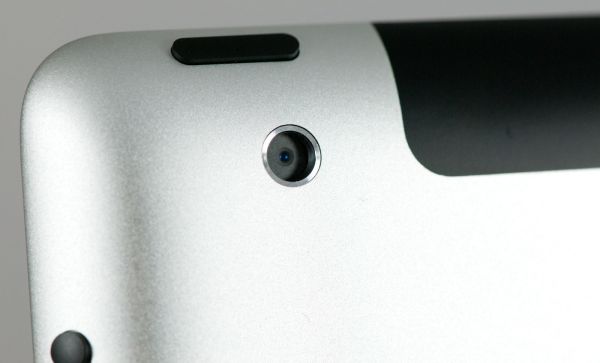
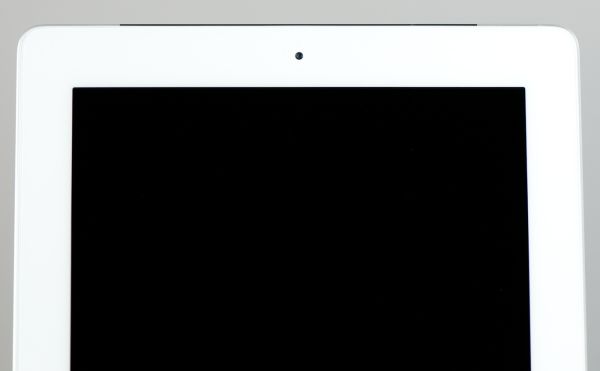
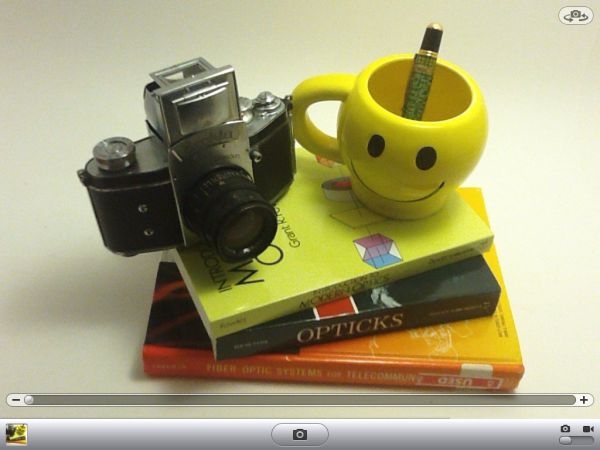
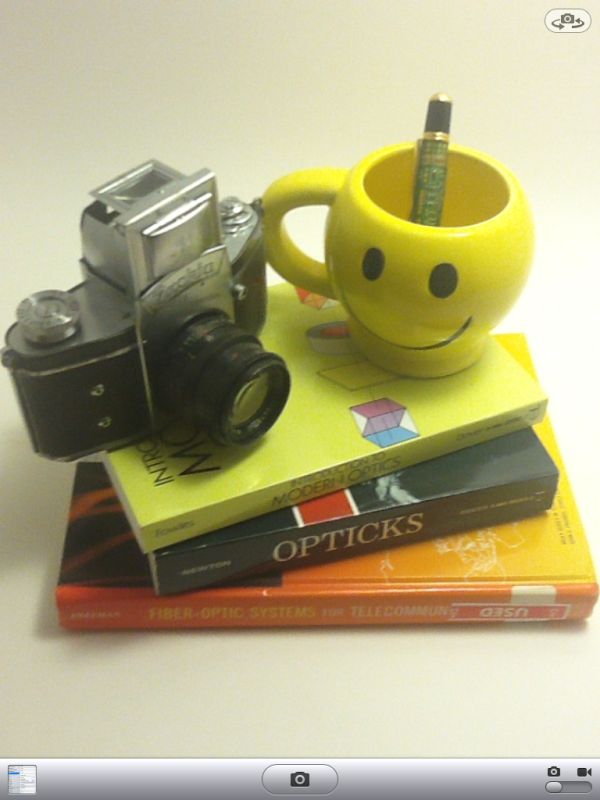
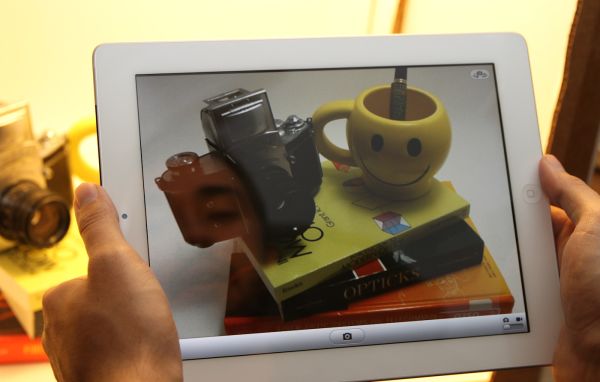
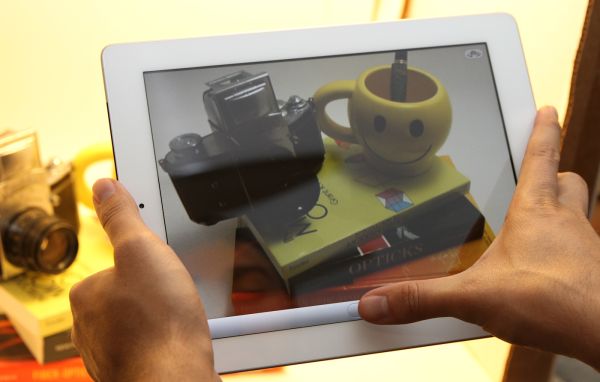
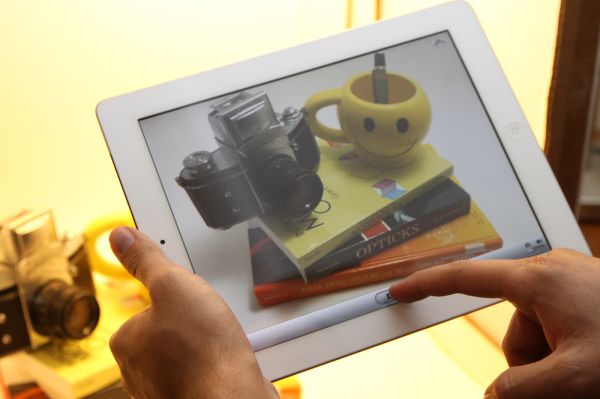
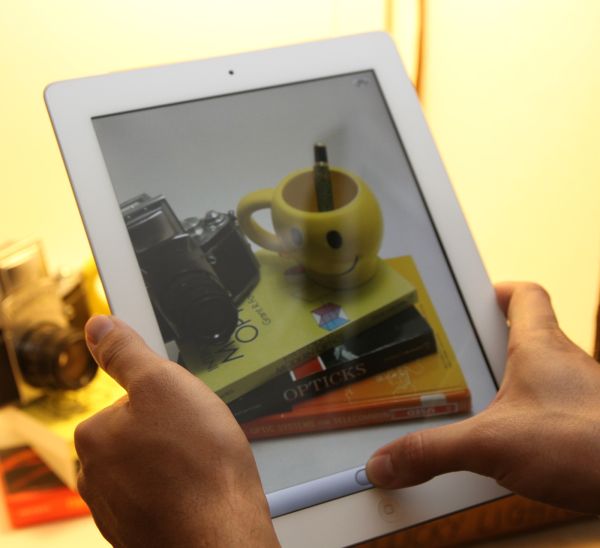
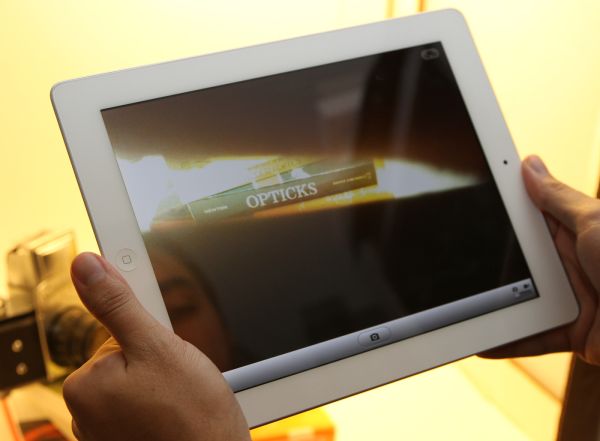








189 Comments
View All Comments
Anand Lal Shimpi - Monday, March 21, 2011 - link
The Xoom review was really written from the perspective of an iPad alternative, while I felt like we covered much of what made the iPad 2 different in our preview and wanted to focus on the bigger picture in the review.The Xoom's multitasking and notifications I believe make it easier to integrate into my workflow, but still not perfect. However Apple has been ergonomics than the Xoom, seemingly better (non-Flash) webpage compatibility, better stability and a smoother UI so it's a tradeoff.
Personally, I'd probably carry the iPad 2 thanks to improved ergonomics (especially with a smart cover) and non-smooth UI frame rates do bother me. But given my workflow neither is sufficient for me to use exclusively when traveling. That's why I mention that both camps have things to work on, whichever gets there first should get your money if you're really on the fence.
Take care,
Anand
Death666Angel - Sunday, March 20, 2011 - link
How do you get to the number in the chart? It would make sense to use the average of all 4 displays, but you don't seem to do that:406 + 409 + 352 + 354 = 1521
1521 / 4 = 380,25 ~ 380
Am I missing something here?
Also, the contrast should be 861:
966 + 842 + 778 + 859 = 3445
3445 / 4 = 861,25 ~ 861
Black levels should be better however:
0,42 + 0,45 + 0,49 + 0,41 = 1,77
1,77 / 4 = 0,4425 ~ 0,44
kmmatney - Sunday, March 20, 2011 - link
The point of having the numbers separate was to show the difference between the WiFi and "WiFi+3G" versions.Death666Angel - Monday, March 21, 2011 - link
And my question wasn't about that at all. The numbers in the actual charts they use for comparison against the iPad1 and the Xoom are not corresponding to any of the 4 distinct iPad2s. So I was wondering where they got the numbers from, if they averaged them or whatnot. If they did average them, then they made a few mistakes in the process. :-) If they got them through some other means it would still be interesting to know which they used.buff_samurai - Sunday, March 20, 2011 - link
speaking about workflow.
I am running a small consulting company for food/pharma industry, my expertise is in analytical instrumentation. Right now I'm using a beefy PC for CAD/backups and IP4/ipad for everything else: emails, project management, crm and documentation all squeezed into a small and portable device (terminal).
Although I am not 100% happy with exchange support in iOS, security, syncing etc I see myself more efficient then ever and that simply means more time/money in my pocket.
Lets try a common scenario: in a car, take a call, pull over, grab a laptop from a bag, power up, check some details, email couple of pdfs and do all that with customer hanging on the phone. Repeat the whole thing 10 times or more - you will see where I am coming from. Or try to carry your laptop around any mid size production line, control room and boardrooms and impress other engineers with questions like: 'where can I plug my laptop' at the same time.
I can understand that for most of heavy laptop users ipad is just useless but lets face the fact that there are millions of professionals on the road and all they care for is better response time and flexibility.
I could spend hours listing applications where no PC (portable or not) can match a tablet but the bottom line is: when moving to new tech we need to overcome our habits first. ipad, xoom and other are like a nice and shiny screwdriver but you will never find a use for it with pockets full of nails. That means no reviewer should ever comment on any device without actually making it a primary tool for couple of months: and if there is no time/money for it - just focus on things that are traceable or you may use your reputation.
darwiniandude - Sunday, March 20, 2011 - link
I always love Anandtech reviews, they cover 'everything' really well, advantages and flaws with equal gusto.Thanks!
Two points:
1) Page 19 I think you're referring to iDisk, not iDrive. Doesn't really matter unless someone trys to Google it.
2) With regard to web browsing, I know you're comparing these units as shipped, but I strongly recommend pro users consider 'iCab' from the AppStore, I don't use Safari much anymore. Propper tabs, full screen, downloading, browser user agent ID spoofing, way more powerful. Scroll pad to quickly navigate huge pages, gestures etc. Tt's very anti-iOS in that it's insanely powerful rather than designed to be simple, but I love it, specifically options like 'open bookmark in new tab' and 'open links from different domain in new tab' very customisable, plugins, blah blah blah. Anyway. It has Desktop style tabs. I wouldn't suggest you change the article, or review this or other 3rd party browsers because it's kinda beyond the scope of the review of the device, but it would be nice if people knew there were alternatives to give a more desktop style (still sans-flash) browser.
pja - Sunday, March 20, 2011 - link
I have really wanted an iPad ever since they were released. Several months ago I had the money (the previous barrier to acquisition) so I went looking. I didn't want the 3G version, WiFi would be fine. But I knew I would not be happy unless I got the one with maximum ram. Well in Australia that was going to cost me over AUD1,000 (I thought they were much cheaper :-( ).Just before this I had built myself a new desktop with an AMD processor and graphics card; see I'm a fan of AMD (but not a bigot). So might I be better off with a netbook rather than an iPad. AMD had recently released the Brazos range. So I started to do some research.
The result was my purchase of a Toshiba NB550D (the sexy orange one) which is a "little under-done" with the C50 Fusion Processor, only 1 Gb of memory and Windows 7 Starter. I have upgraded the memory to 2 Gb (still not enough) and installed Windows 7 Home Pro.
The Toshiba is about the same size as an iPad but is much more functional, it has all my desktop PC's apps installed (particularly my favourite text editor (EditPlus), my browser (Firefox) and all the same bookmarks, etc. etc.) so when I travel I have everything I need and I didn't need to learn how to use new software.
I still think the iPad is a great bit of gear but that's when I use the right side of my brain. My left side says "where's the value proposition?" We are all different but for me the left side of my brain always tends to win over the right side. I am very happy with "my" iPad alternative; more memory and the C-350 processor would be good (but not the larger form=factor that seems to entail). Oh! I forgot to say that the total cost of the Toshiba (including hardware and software upgrades was about AUD675 - more than AUD325 saving!
Regards,
Peter
Deepcover96 - Sunday, March 20, 2011 - link
Great review. Anandtech's reviews are always well worth the wait. They are always thorough and I always learn something. I agree that it is a luxury device and it is hard to justify it for getting work done. I still purchased an iPad 1. I recently sold it to buy the iPad 2, as soon as I can find one. I do think you downplay how important the app selection is on iOS as compared to Android.name99 - Sunday, March 20, 2011 - link
Reading the summary of what all three authors think of iPad feels to me like someone who buys an iPod because it has calendar and contact functionality, and then is upset/surprised that it isn't a Palm.iPad is not a REPLACEMENT for a laptop/desktop, it is an AUGMENTATION. You use each for what they are good at. If you find yourself spending most of your time traveling and you need a full-featured computer during that time then, sure, adding iPad to the mix is stupid. But if you already have a laptop, and can afford it, iPad makes certain tasks a lot more pleasant.
For my part, for example, my primary use for iPad is reading technical PDFs using Good Reader. I could read these on a laptop, but the keyboard really gets in the way (not to mention that the aspect ratio of the screen is inappropriate). If you don't do much reading of technical PDFs, this might seem dumb to you --- but I DO spend many hours a day reading these PDFs and I appreciate a tool that does the job properly, just like a professional carpenter doesn't use a $5 saw he bought at Walmart.
The future of computing is not one device that does everything; it is multiple devices all optimized to a particular human form factor, that all work together --- an iPod nano AND an iPhone AND an iPad AND a laptop AND a desktop. Criticism of something germane to this vision is legitimate and sensible (and Apple's flailing regarding how much of the file metaphor it wants to present to users is a legitimate part of this criticism.) But complaints whose primary structure is "this device doesn't work exactly like a device I already own" is just stupid --- like complaining that a bicycle isn't a car.
It's perfectly reasonable to say that you don't have a use for a certain class of device, especially because you already use something more powerful. I, for example, have no use for a Tivo or a video streaming devices like WD Live or Roku --- I have a full-fledged computer hooked up to my TV. But it is unreasonable to go further than that, and I've observed plenty of non-techy people who are very happy with their WD Live's or Tivos.
It's even more unreasonable to complain that "Tivo sucks because it doesn't play DVDs".
Use some sense. Don't keep trying to use iPad for things it is no good at. Keep in the bedroom, and use it to read, or to look up something quickly on the net, or to play a movie just before you go to sleep. Don't be insane and try to write a novel on it.
pja - Monday, March 21, 2011 - link
"iPad is not a REPLACEMENT for a laptop/desktop, it is an AUGMENTATION. You use each for what they are good at. If you find yourself spending most of your time traveling and you need a full-featured computer during that time then, sure, adding iPad to the mix is stupid. But if you already have a laptop, and can afford it, iPad makes certain tasks a lot more pleasant."You must have either too much cash or too much time on your hands or both. A good business class laptop is AUD1,500+ while a top of the range iPad is AUD1,000 + here in Australia.
It seems to me when you think about the iPod with your left brain there is very little functionality that a good netbook does not do both better and cheaper. However, I would agree that when you let your right brain rule then all of a sudden the iPad becomes a irresistible thing that you must possess. Unfortunately for me my left brain clicks in when I pull out my credit card.
Peter